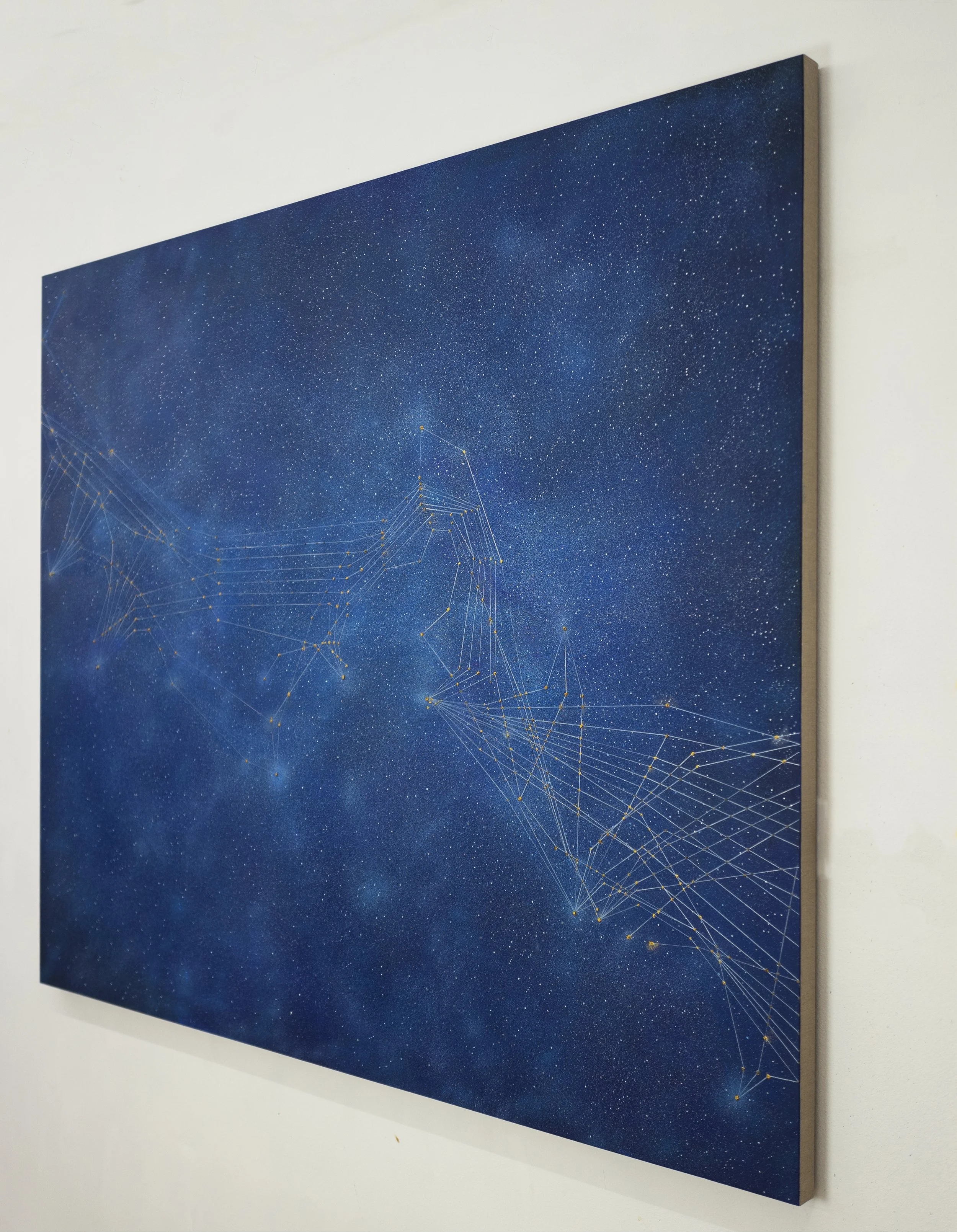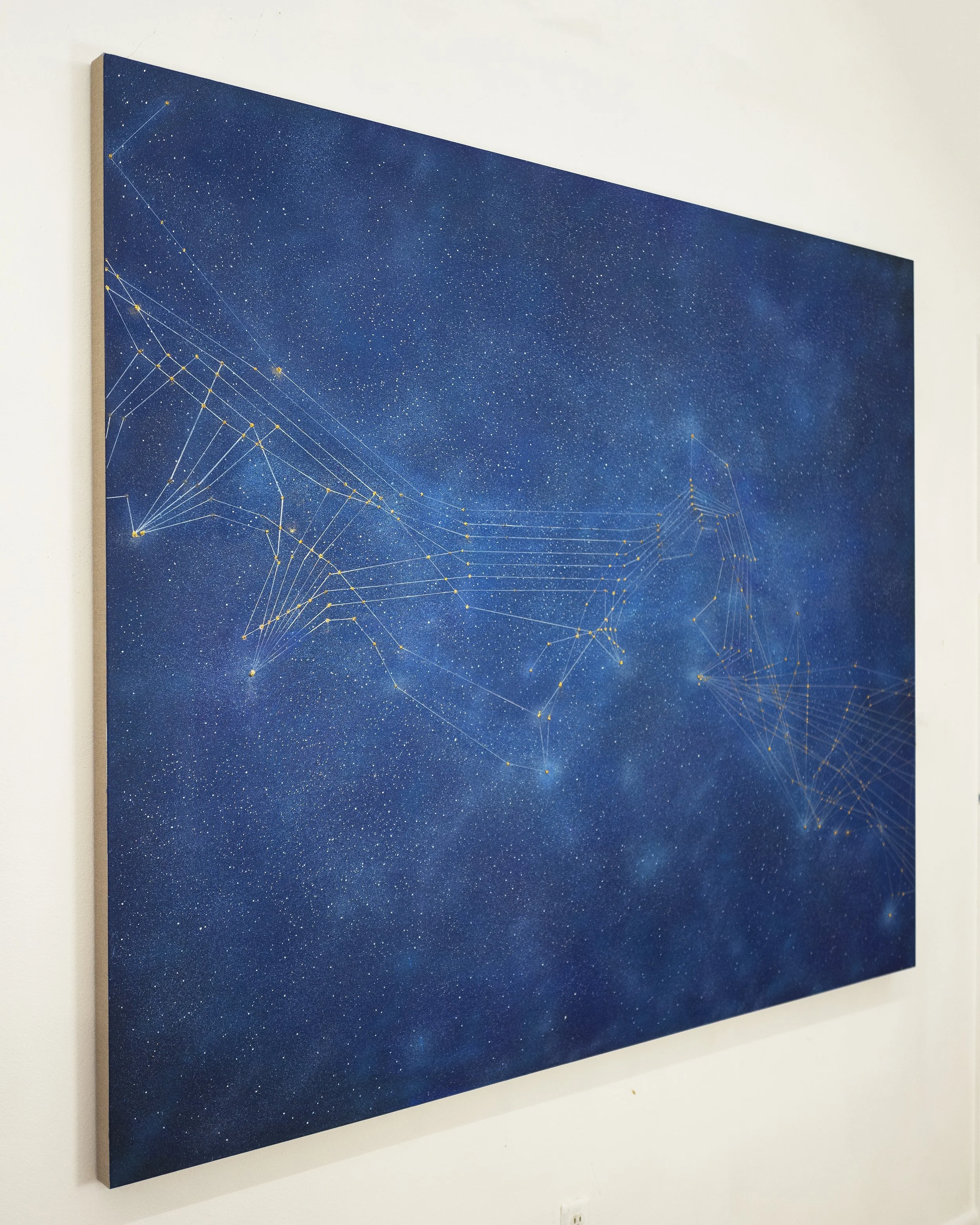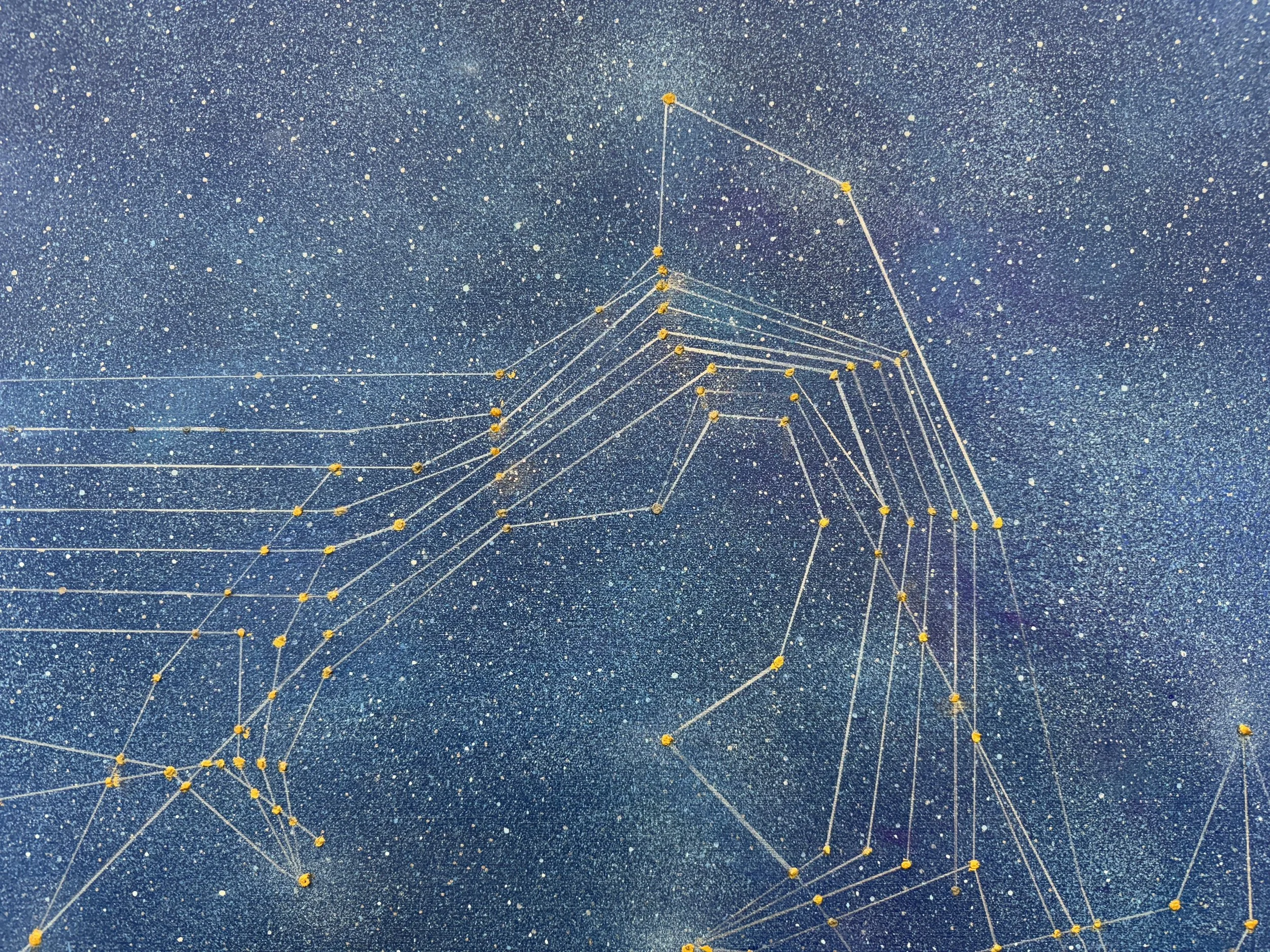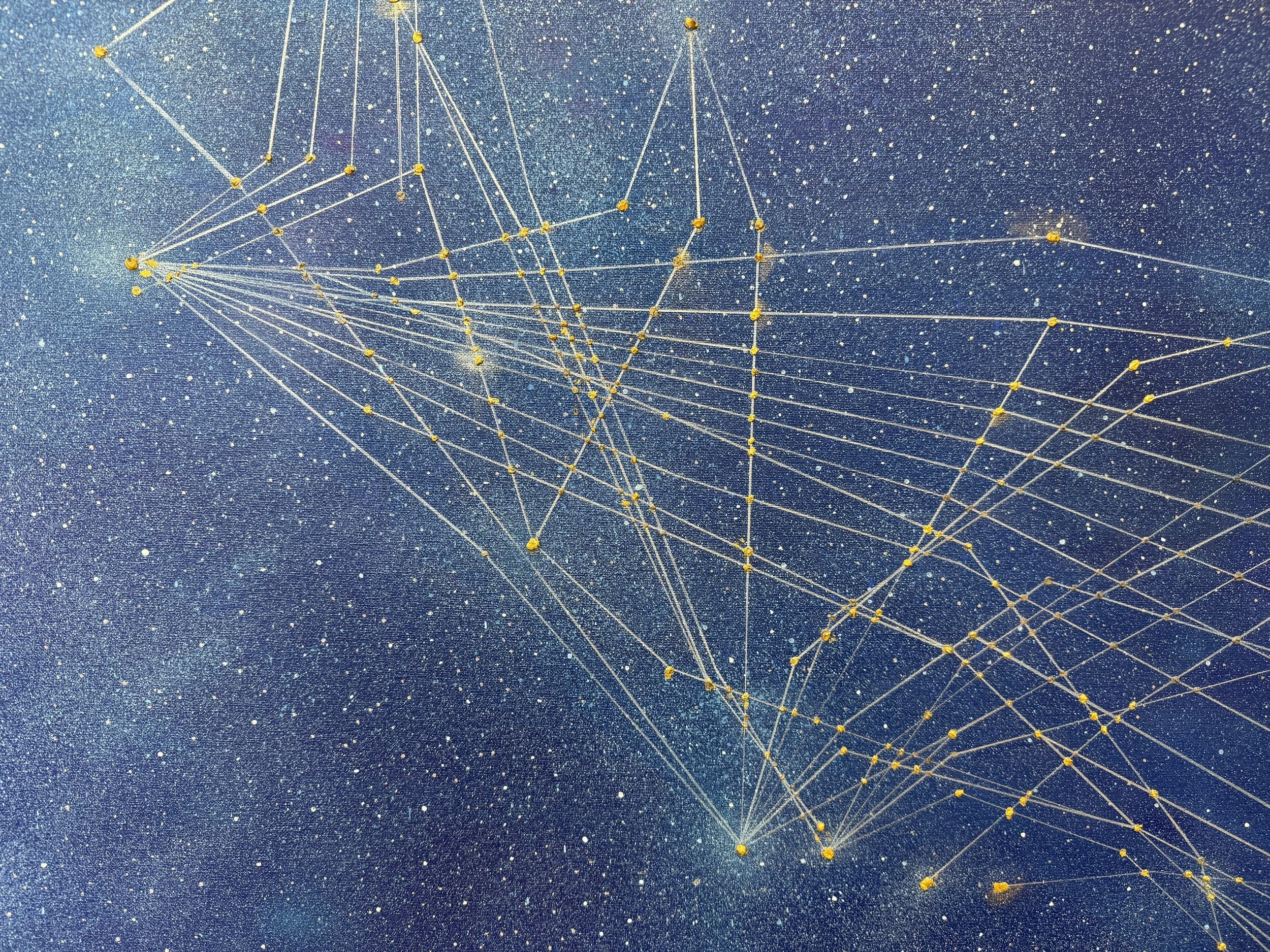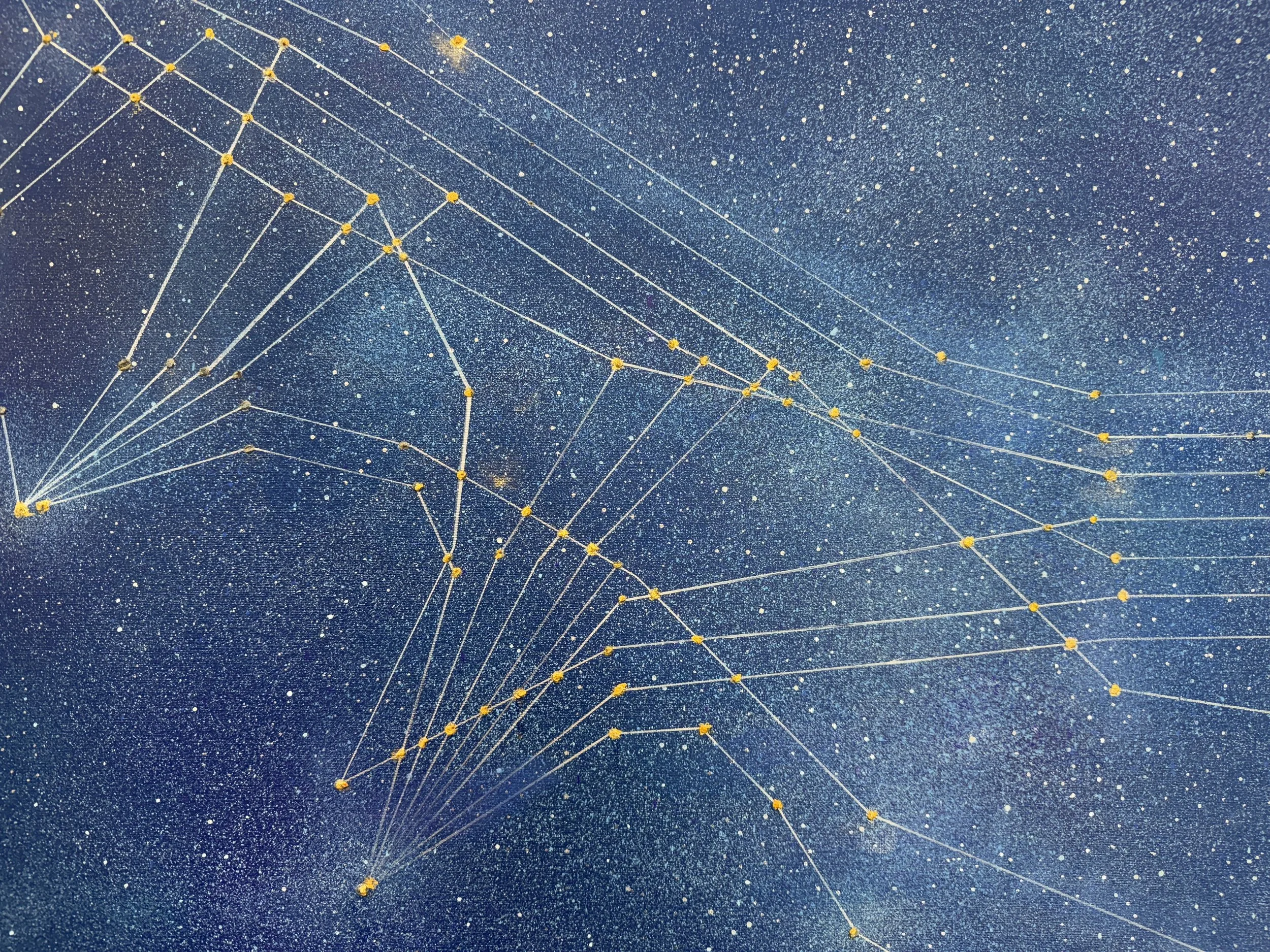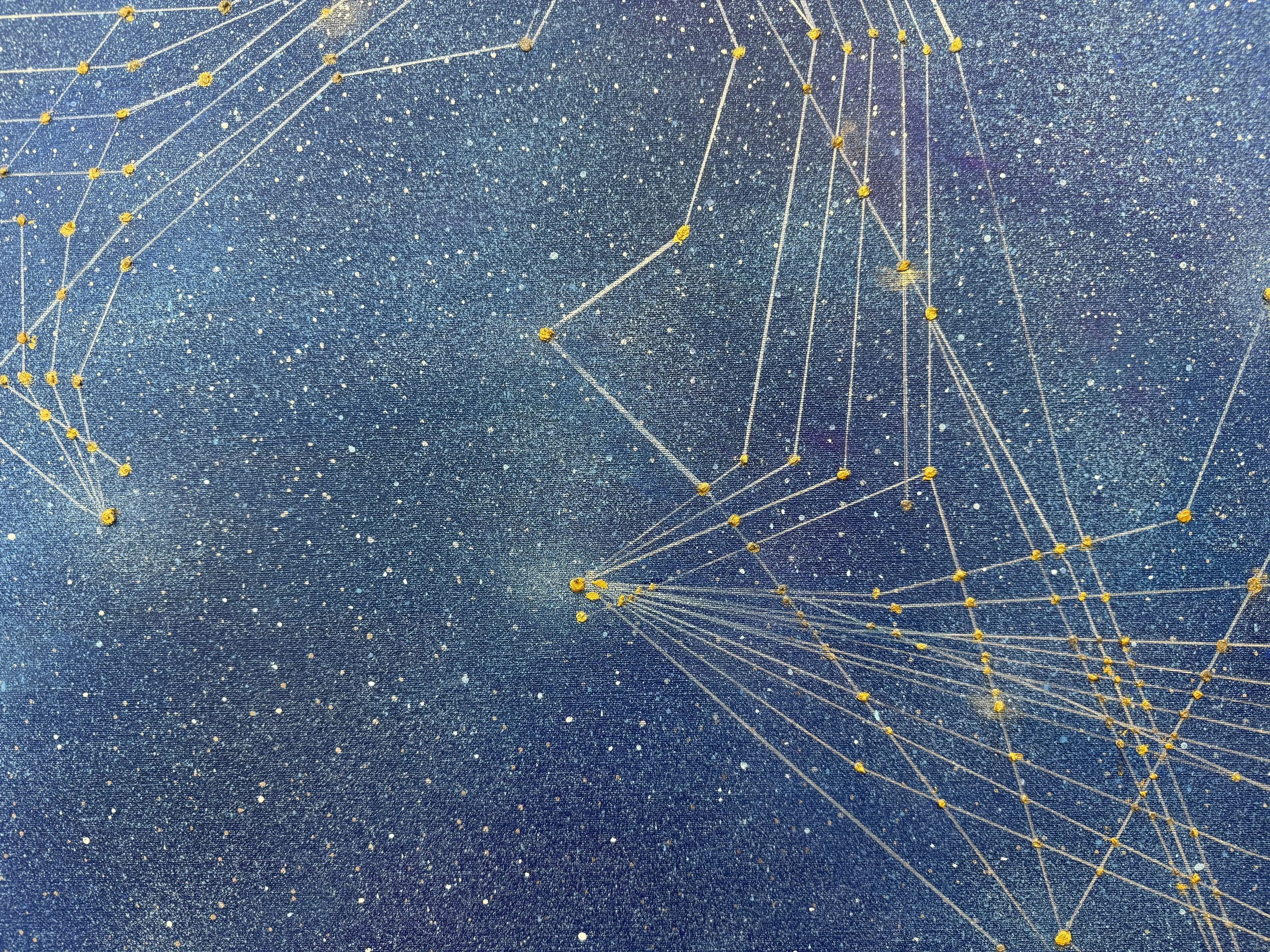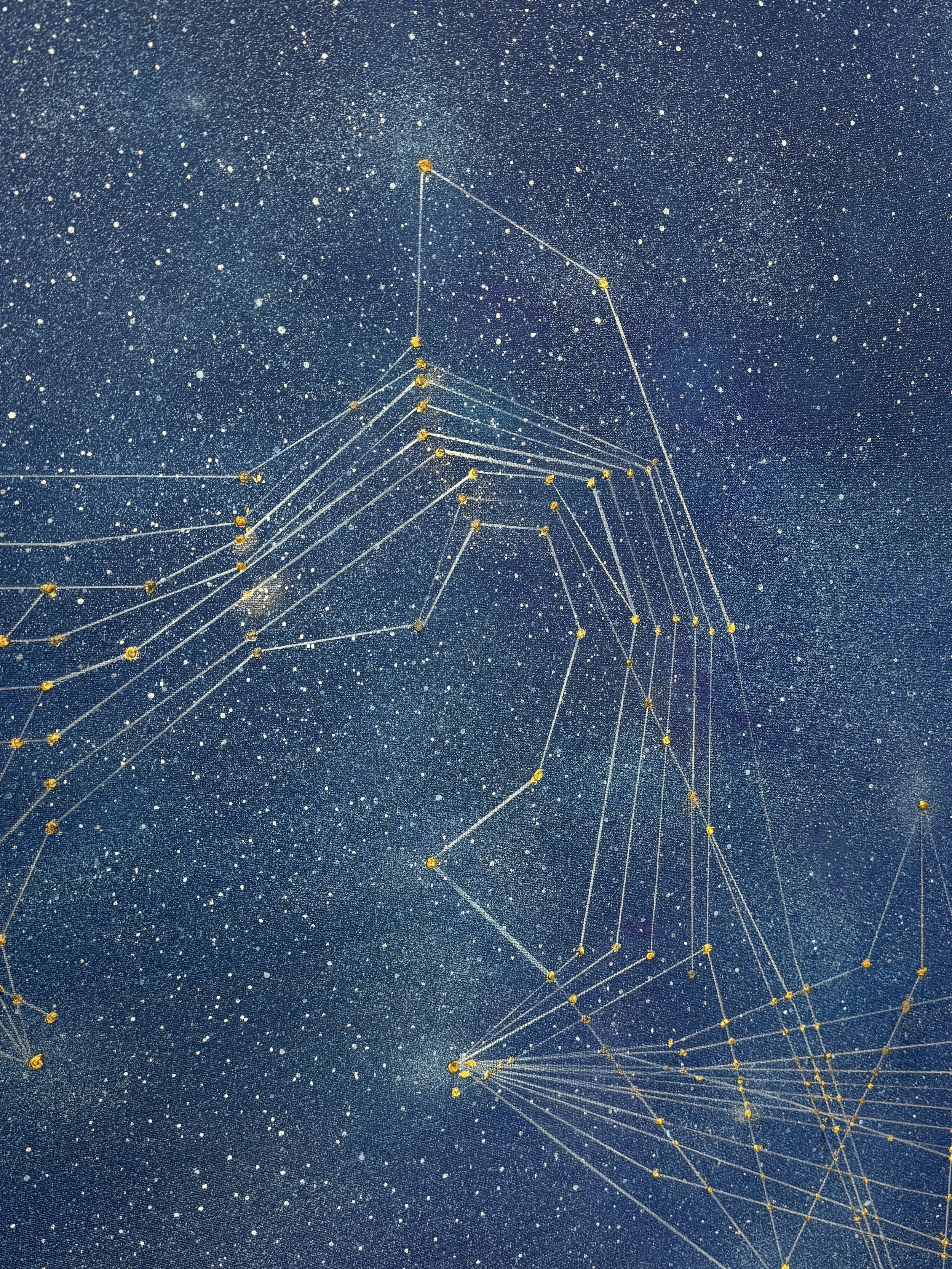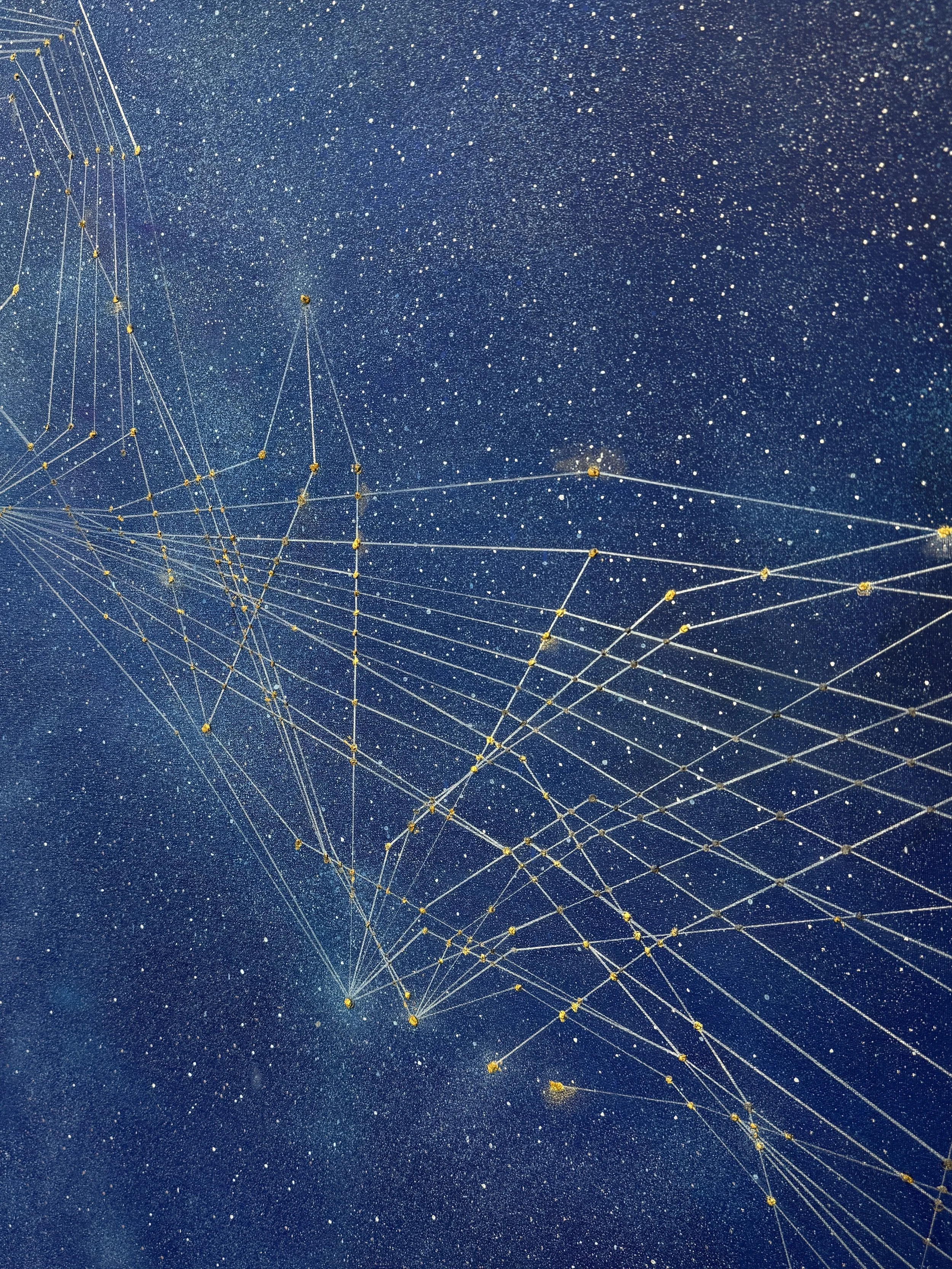Signal : Submarine Network 03, 2025
Signal: Submarine Networks 03 (Dubai), 2025
Oil and acrylic on linen
152.5 x 183 cm ( 60 x 72 in)
Signal 03 (Dubai) depicts the submarine communication lines spanning the waters from the Persian Gulf to the Gulf of Oman, primarily featuring cable systems such as Fiber Optic Gulf (FOG), Tata TGN-Gulf, and FALCON. The artwork highlights the role of these submarine cables in global data transmission. Through an intricate network of lines, it visualizes these hidden infrastructures, exploring how data flows in the digital age connect different regions beneath the ocean's depths.
Earth, our shared home, functions like a vast motherboard, where submarine cables form the invisible pathways connecting supercities. These unseen networks carry humanity’s collective knowledge and emotions, fueling breakthroughs and sustaining our interdependence. Yet, even as we remain tethered to our mother planet, our gaze reaches the stars, seeking guidance and hope in the cosmic expanse.
Signal poetically bridges technology and human sentiment, the interplay between Earth and the cosmos, and the vital role of art in archiving collective memory. Tan Mu arranges abstract dots to form a "digital constellation," where the connections between nodes and cables merge cosmic vastness with oceanic depth. Each dot symbolizes a digital node and a trace of "white noise," embodying the subtle, continuous flow of data and human connection. For Mu, technology is not merely functional; it is an extension of the body and an externalization of memory. Her works trace the flows of knowledge and emotion across oceans, emphasizing the expanding web of human connection while linking historical narratives to speculative futures.
Inspired by The Classic of Mountains and Seas, an ancient text mapping the mythical and the unknown, Signal transforms the unseen digital networks of our era into a contemporary narrative. Like ancient chroniclers who charted mystical landscapes, Signal explores the uncharted digital world, blending the poetic mythology of starry constellations with the tangible structure of global connectivity.
As an ongoing project, Signal evolves over time, embodying the fluidity of the digital age and recording the technological and emotional timestamps of our era. It captures the duality of connection and isolation, exploring how humanity navigates an increasingly interconnected yet fragile world. At its core, Signal preserves the ineffable—our shared memories, dreams, and aspirations—offering a contemplative space to imagine new futures while grounding us in the rhythms of our collective past.
Tan Mu’s work delves into the hidden networks that sustain and shape our world, from the physical structures of submarine cables to the conceptual geometry of human connection. By uncovering the interplay between structure, data flow, and human emotion, she invites viewers into a meditative reflection on the digital and existential threads that bind us across time, space, and imagination. Her works trace the flow of knowledge and emotional bonds, emphasizing the expanding web of human connection and linking historical narratives to speculative futures.
What sparked your deep interest in the ocean?
Tan Mu: The inspiration for the Signal series stems from my profound fascination with the ocean, a sentiment rooted in my childhood spent by the sea. My mother was a professional windsurfer, and during my childhood, I often went on sailing adventures with my family to explore the mysteries of the ocean. Additionally, my grandfather, as a marine engineer, worked on large-scale marine projects such as land reclamation and port design. His engineering blueprints and designs exposed me early on to the complex structures and mechanical engineering of the ocean, as well as marine maps, elements that revealed the hidden depths of the ocean and deeply captivated me. As a diving enthusiast, whenever I dive into the deep sea and reach the neutral buoyancy point, the vastness of the ocean makes me feel as if I am suspended in another world, surrounded by marine life like stars. The ocean is not only a massive physical entity but also a treasure trove of collective memory and a source of inspiration for memory structures, all of which are reflected in my depiction of the ocean in the Signal series.
How did your exploration of the ocean evolve into the inspiration for the Signal series?
Tan Mu: The Signal series originated from my 2022 work Eruption about the Tonga volcanic eruption. As a free diving enthusiast, I have always been attracted to the island nation of Tonga, dreaming of one day witnessing its majestic humpback whales. Therefore, I have been following Tonga's news. In January 2022, the eruption of the Hunga Tonga-Hunga Ha'apai volcano severely damaged submarine cables, cutting off Tonga's connection with the outside world. This event made me realize for the first time how much modern society's global communication relies on the hidden infrastructure of submarine cables, far more than on satellites. A month later, when Tonga restored its communication, I began creating Eruption, symbolizing the process of reconnection. This piece not only documented the event but also reflected how the fragility and resilience of modern technology shape our lives and deepened my curiosity about submarine cables. In my 2023 painting Twenty Thousand Leagues Under the Sea, I began exploring the material structures of these cables, focusing on the cross-sectional material construction to visualize their complex internal operations and connection functions. In the Signal series, I delve into submarine cables as a metaphor for global connection, serving not only as channels for data but also as records and transmitters of human collective memory. From my love for the ocean and the Tonga event to submarine cables and their global perspective, Signal has become a long-term project exploring the interaction between technology and emotion. This series, based on maps and submarine cable networks, reveals the complexity of modern technology while delving into shared human emotions and cultural memories, narrating a continuously evolving story of connection and the future, combining the complexity of technology with profound emotional and philosophical depth.
Why did you choose to start this series with a depiction of the Northwest Pacific region?
Tan Mu: The first painting in the Signal series begins with the Northwest Pacific because this region includes my hometown, making it personally significant to me. The cable network in this area connects the East China Sea, South Korea, and Japan, among others, making it feel like a natural starting point for a global project. From here, I wanted to root this exploration of global connection in something intimate, capturing geographical and emotional anchors. Starting from this point, from my hometown, it has now expanded to submarine cables near the waters of Hong Kong and Dubai, with different sea scenes presenting unique submarine cable nodes and network layouts, gradually mapping out the intricate global submarine cable network that connects us all.
How does this series reflect your interest in hidden structures and invisible connections? You mentioned viewing this network as an extension of the body. Could you elaborate on that?
Tan Mu: I have always been fascinated by the hidden frameworks that underpin modern life—those structures that quietly connect everything but are often overlooked. Submarine cables are a perfect example: they lie beneath the water's surface, invisible yet crucial. Through this series, I aim to highlight these "invisible veins" of the world. They remind me of the meridian lines in traditional Eastern medicine, connecting different parts of a whole and maintaining a global "circulation." By revealing these hidden structures, I hope to evoke a sense of wonder and appreciation for the unseen forces that shape our interconnected lives. At the same time, these deeply buried submarine cables, as conduits for transmitting information, allow us to see, hear, and understand instant information across oceans, tightly connecting us together. This embodies the concept I always convey: technology as an extension of the body and an externalization of memory. This exploration connects with my previous works, where the extension of body and memory links internal memory transmission systems, including synapses (Synapse, 2023), neural pathways (Emergence, 2022; Emergence 2, 3, 2024), and the brain itself (MRI, 2021), with external memory formed through technological systems, including circuits (Logic Circuit, 2022), submarine cables (Twenty Thousand Leagues Under the Sea, 2023; Signal: Submarine Network 01, 2024), and data centers (Memory, 2019). It forms a metaphorical body, reminding us that we are all closely connected.
How do you see the similarities between this network and constellations?
Tan Mu: Visually, submarine cables resemble star charts when visualized, with interconnected points and lines spanning great distances. This recurring metaphor links the micro (data points, neural networks) with the macro (global systems, the universe). The submarine network transforms into modern constellations, showcasing the profound interconnectedness of humanity. This constellation-like network symbolizes how we explore, understand, and map the world. Just as the stars guided early navigators, this network connects and guides modern society, helping us comprehend the vastness of human connection.
The Signal series presents the interplay between data nodes and constellations, astonishingly merging the starry sky and the ocean in a single frame. Could you talk about the conceptualization of the visual language in this series?
Tan Mu: The perspective of the composition comes from my diving experiences. Only when you dive into the ocean and look upwards do the sea and the starry sky intertwine. Here, the sky (starry sky), the earth (ocean), and humans (submarine cables) are connected on one plane. Through outlined points and lines, and layers of rendered blues with varying hues, the painting presents itself between abstraction and figuration, merging the poetic mythology of constellations with the tangible structures of global connectivity. The dots in the work have multiple meanings. On one hand, they represent data packets flowing through these cables—an abstract visualization of information transmitting across the ocean. On the other hand, they evoke a sense of "white noise" or pixelation, almost like visual static of data flow. These dots convey the randomness and structure within the flow of information, inviting viewers to reflect on how these countless fragments of data collectively build the ongoing stream of global communication. They also remind us of the hidden pulse of digital life—an invisible, endless rhythm that underpins our daily interactions. The arrangement of the dots simulates both constellations and the data flow in networks, metaphorically connecting the ocean and the sky, and symbolizing the interconnectedness of global collaboration. By juxtaposing the instantaneous transmission of data with the meticulously designed infrastructure, and the eternal tranquility of starlight with human collective labor, I transform these cold technological symbols into warm collective memories. When viewers gaze at these "digital constellations," they see not only an abstract representation of the information age but also stories of connection, woven into a narrative network that spans nature, technology, and human labor.
How does this series link technology, human experience, time, and labor?
Tan Mu: Submarine cables are a powerful extension of our human need for connection, combining technology with profound human effort. These cables symbolize our desire to communicate, share, and understand each other across vast distances, but they are also material achievements built through meticulous human labor, with each kilometer laid through immense collaboration. Each dot in my work reflects this, representing not only data points but also the time, patience, and labor involved in creating these networks. This thoughtful meditative process contrasts with the rapid flow of information on the cables, reminding us of the human presence behind these invisible systems and honoring the dedication required to build what unites us globally. If a painting can pull someone into a broader world perspective, reminding them of this profound coexistence and unity, it is truly a marvelous experience.


